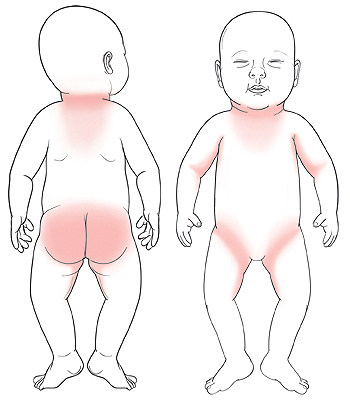A
B
C
D
E
F
G
H
I
J
K
L
M
N
O
P
Q
R
S
T
U
V
W
X
Y
Z
Click a letter to see a list of medical procedures beginning with that letter.
Click 'Back to Intro' to return to the beginning of this section.
When Your Child Has Heat Rash (Prickly Heat)
Heat rash (also called prickly heat) is a common problem in children, especially babies. It causes small red bumps on the skin. It appears most often on the neck, buttocks, and skin folds. But it can appear anywhere on the body. Heat rash is not serious. It can easily be treated at home.
 |
| The shaded areas are common sites of heat rash in babies. |
What causes heat rash?
Heat rash is caused by blocked sweat glands. This can happen when your child:
-
Is exposed to too much sun or heat
-
Is overdressed (wearing too many layers of clothing)
-
Engages in intense exercise or physical activity
What are the symptoms of heat rash?
Heat rash can cause parts of the skin to turn red and develop small bumps. The skin can also itch.
How is heat rash diagnosed?
Heat rash is diagnosed by how it looks. To get more information, the healthcare provider will ask about your child’s symptoms and past health. The healthcare provider will also examine your child. You will be told if any tests are needed.
How is heat rash treated?
In most cases, heat rash doesn't need treatment. It often goes away on its own within 2 to 3 days. You can do the following at home to help ease your child’s symptoms:
-
Apply a cool compress (such as a clean washcloth dipped in cool water) to the rash.
-
Put your child in a cool environment
-
Give your child cool baths.
-
Loosen your child’s diaper if it rubs against the rash area.
-
Dress your child in breathable clothing, such as cotton. Have your child wear as few layers of clothing as possible.
-
Apply over-the-counter hydrocortisone cream to the rash, as directed by your child's healthcare provider. This may help ease itching. Don't put the steroid cream under the diaper. Each time before and after applying the cream, wash your hands with clean, running water and soap. Don't use ointment. This can block sweat glands.
Call the healthcare provider
Call your child's healthcare provider if any of the following occur:
-
A heat rash that doesn’t go away within 3 days of starting treatment
-
Other symptoms, such as a fever, sore throat, or body aches. This may suggest an illness or infection.
-
Rash looks infected (spreading redness, or pus)
-
Fever (see Fever and children, below)
-
A seizure caused by the fever
Fever and children
Use a digital thermometer to check your child’s temperature. Don’t use a mercury thermometer. There are different kinds and uses of digital thermometers. They include:
-
Rectal. For children younger than 3 years, a rectal temperature is the most accurate.
-
Forehead (temporal). This works for children age 3 months and older. If a child under 3 months old has signs of illness, this can be used for a first pass. The provider may want to confirm with a rectal temperature.
-
Ear (tympanic). Ear temperatures are accurate after 6 months of age, but not before.
-
Armpit (axillary). This is the least reliable but may be used for a first pass to check a child of any age with signs of illness. The provider may want to confirm with a rectal temperature.
-
Mouth (oral). Don’t use a thermometer in your child’s mouth until they are at least 4 years old.
Use a rectal thermometer with care. Follow the product maker’s directions for correct use. Insert it gently. Label it and make sure it’s not used in the mouth. It may pass on germs from the stool. If you don’t feel OK using a rectal thermometer, ask the healthcare provider what type to use instead. When you talk with any healthcare provider about your child’s fever, tell them which type you used.
Below is when to call the healthcare provider if your child has a fever. Your child’s healthcare provider may give you different numbers. Follow their instructions.
When to call a healthcare provider about your child’s fever
For a baby under 3 months old:
-
First, ask your child’s healthcare provider how you should take the temperature.
-
Rectal or forehead: 100.4°F (38°C) or higher
-
Armpit: 99°F (37.2°C) or higher
-
A fever of ___________as advised by the provider
For a child age 3 months to 36 months (3 years):
-
Rectal or forehead: 102°F (38.9°C) or higher
-
Ear (only for use over age 6 months): 102°F (38.9°C) or higher
-
A fever of ___________ as advised by the provider
In these cases:
-
Armpit temperature of 103°F (39.4°C) or higher in a child of any age
-
Temperature of 104°F (40°C) or higher in a child of any age
-
A fever of ___________ as advised by the provider
How is heat rash prevented?
You can help prevent your child from getting a heat rash:
-
Remove extra layers of clothing from your child when it’s warm. Children should not wear more than 1 extra layer of clothing than adults.
-
Dress your child in loose-fitting clothing that does not rub against the skin.
-
Change your child’s diaper right away when it’s wet or soiled.
Online Medical Reviewer:
Amy Finke RN BSN
Online Medical Reviewer:
Liora C Adler MD
Online Medical Reviewer:
Stacey Wojcik MBA BSN RN
Date Last Reviewed:
11/1/2022
© 2000-2024 The StayWell Company, LLC. All rights reserved. This information is not intended as a substitute for professional medical care. Always follow your healthcare professional's instructions.